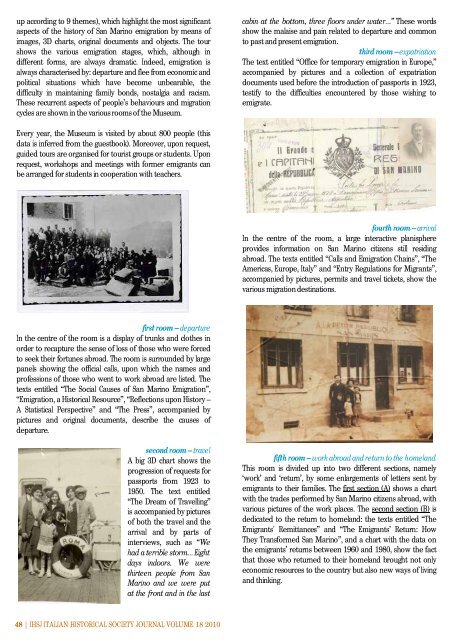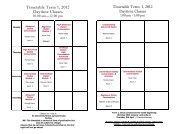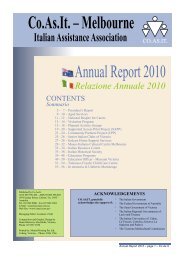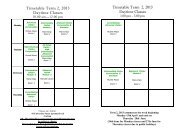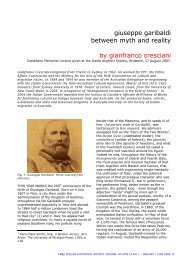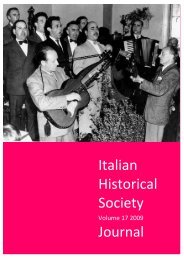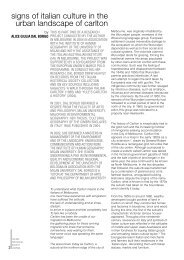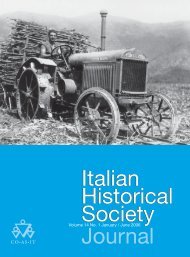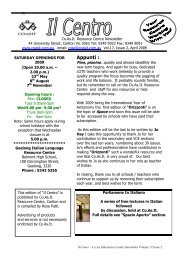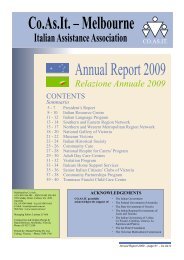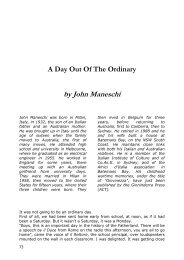January-December 2010, vol. 1
January-December 2010, vol. 1
January-December 2010, vol. 1
- No tags were found...
You also want an ePaper? Increase the reach of your titles
YUMPU automatically turns print PDFs into web optimized ePapers that Google loves.
up according to 9 themes), which highlight the most significantaspects of the history of San Marino emigration by means ofimages, 3D charts, original documents and objects. The tourshows the various emigration stages, which, although indifferent forms, are always dramatic. Indeed, emigration isalways characterised by: departure and flee from economic andpolitical situations which have become unbearable, thedifficulty in maintaining family bonds, nostalgia and racism.These recurrent aspects of people’s behaviours and migrationcycles are shown in the various rooms of the Museum.cabin at the bottom, three floors under water…” These wordsshow the malaise and pain related to departure and commonto past and present emigration.third room – expatriationThe text entitled “Office for temporary emigration in Europe,”accompanied by pictures and a collection of expatriationdocuments used before the introduction of passports in 1923,testify to the difficulties encountered by those wishing toemigrate.Every year, the Museum is visited by about 800 people (thisdata is inferred from the guestbook). Moreover, upon request,guided tours are organised for tourist groups or students. Uponrequest, workshops and meetings with former emigrants canbe arranged for students in cooperation with teachers.fourth room – arrivalIn the centre of the room, a large interactive planisphereprovides information on San Marino citizens still residingabroad. The texts entitled “Calls and Emigration Chains”, “TheAmericas, Europe, Italy” and “Entry Regulations for Migrants”,accompanied by pictures, permits and travel tickets, show thevarious migration destinations.first room – departureIn the centre of the room is a display of trunks and clothes inorder to recapture the sense of loss of those who were forcedto seek their fortunes abroad. The room is surrounded by largepanels showing the official calls, upon which the names andprofessions of those who went to work abroad are listed. Thetexts entitled “The Social Causes of San Marino Emigration”,“Emigration, a Historical Resource”, “Reflections upon History –A Statistical Perspective” and “The Press”, accompanied bypictures and original documents, describe the causes ofdeparture.second room – travelA big 3D chart shows theprogression of requests forpassports from 1923 to1950. The text entitled“The Dream of Travelling”is accompanied by picturesof both the travel and thearrival and by parts ofinterviews, such as “Wehad a terrible storm… Eightdays indoors. We werethirteen people from SanMarino and we were putat the front and in the lastfifth room – work abroad and return to the homelandThis room is divided up into two different sections, namely‘work’ and ‘return’, by some enlargements of letters sent byemigrants to their families. The first section (A) shows a chartwith the trades performed by San Marino citizens abroad, withvarious pictures of the work places. The second section (B) isdedicated to the return to homeland: the texts entitled “TheEmigrants' Remittances” and “The Emigrants’ Return: HowThey Transformed San Marino”, and a chart with the data onthe emigrants’ returns between 1960 and 1980, show the factthat those who returned to their homeland brought not onlyeconomic resources to the country but also new ways of livingand thinking.48 | IHSJ ITALIAN HISTORICAL SOCIETY JOURNAL VOLUME 18 <strong>2010</strong>


